Your Ultimate Guide to Creating a Business Plan (Step-by-Step Guide)
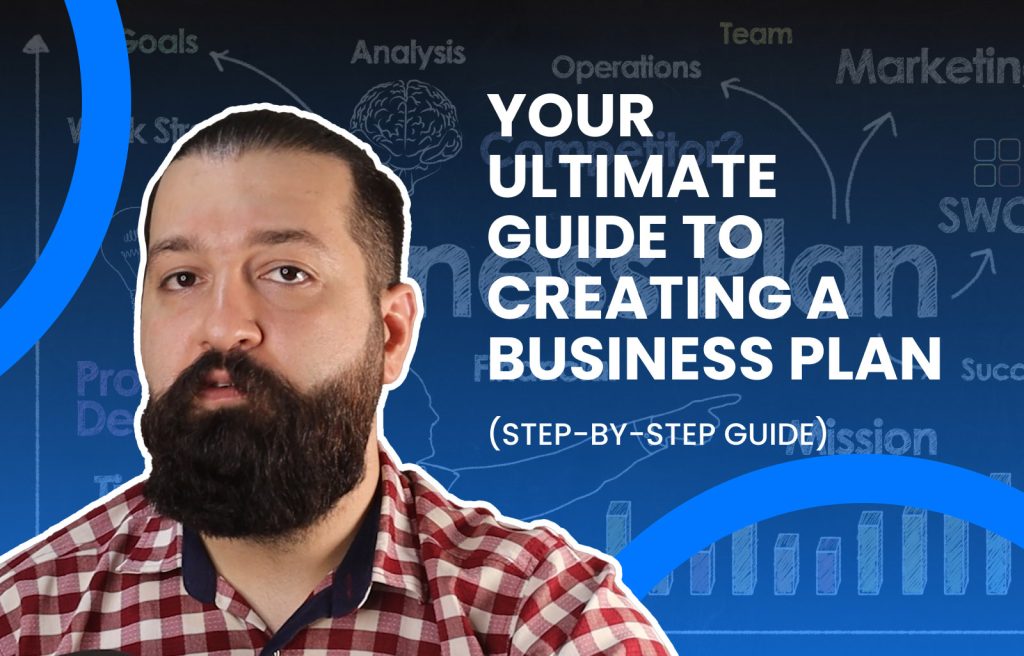
Imagine this: you’re embarking on a cross-country road trip without a map or GPS. You might start off in the right direction, but chances are, you’ll soon find yourself lost, frustrated, and unsure how to reach your destination. In the world of business, your vision is that distant destination, and your business plan is the roadmap to get you there. Without it, navigating the twists and turns of the business landscape can feel like driving blindfolded.
In today’s fast-paced and fiercely competitive business world, the significance of effective business planning cannot be overstated. Whether you’re a startup founder with a groundbreaking idea, a small business owner aiming for growth, or a seasoned entrepreneur looking to adapt to changing markets, having a well-thought-out business plan is your compass. It’s the difference between floundering in uncertainty and confidently charting a course toward success.
Welcome to this comprehensive guide, where we’ll unveil the art of effective business planning, from crafting a compelling vision to executing it with precision. Our mission is clear: to equip you with the knowledge, tools, and strategies you need to create a business plan that not only impresses investors but also guides your business toward its ultimate goals. So, fasten your seatbelt, because we’re about to embark on a journey from vision to execution, where every step counts.
Understanding Business Planning
What Exactly is a Business Plan?
A business plan is like the North Star guiding a company through the vast expanse of the business universe. It’s a meticulously crafted document that spells out a company’s dreams, ambitions, and the concrete steps it’ll take to turn those dreams into reality. Think of it as the captain’s logbook for your entrepreneurial journey, documenting every aspect from marketing strategies to financial maneuvers and operational tactics.
Now, you might wonder, who’s the intended audience for this cosmic roadmap? Well, it’s not just an internal compass; it’s also a dazzling signal to the outer world. For startups, it’s the glittering bait to lure in investors before they can see a track record. It’s the persuasive pitch that convinces financial institutions to open their vaults.
But it’s not all about wooing external forces. A business plan is also the glue that holds your internal team together. It’s your secret code, decipherable only by your top brass, ensuring everyone’s on the same page. It’s a checklist of strategic must-dos that’ll keep the ship sailing towards its chosen constellations of success.
And here’s a nugget of wisdom – it’s not a one-and-done deal. Even if you’re an established player, the universe is ever-expanding, and so should your business plan be. Regular pit stops to review and refuel are essential. Sometimes, it’s not just about updating; it’s about creating a brand-new star map when your business decides to explore uncharted territories.
Define Business Planning
At its core, business planning is the process of charting a clear and comprehensive path for your company’s future. It involves setting specific goals, outlining strategies to achieve them, and detailing the steps to make those strategies a reality. Business planning isn’t just about numbers and financial forecasts; it’s a holistic approach that encompasses every aspect of your venture. It’s the blueprint that ensures your business stays on course, even when faced with unexpected challenges.
Discuss the Purpose
Why does business planning matter? Think of it as the guiding star of your enterprise. Without a well-structured plan, businesses are like ships adrift in a stormy sea. A solid business plan is your compass, steering you toward your long-term goals while helping you navigate through turbulent waters. It provides clarity, direction, and a sense of purpose. In today’s dynamic business landscape, where change is constant and competition fierce, a business plan isn’t a luxury; it’s a necessity. It’s the foundation upon which successful businesses are built.
Explore Types of Business Plans:
Business plans come in various shapes and sizes, each serving a unique purpose. Startup plans, for instance, focus on turning a brilliant idea into a profitable reality. Strategic plans zoom out to provide a high-level view of where your business should be headed in the next few years. Operational plans dive into the nitty-gritty details, outlining day-to-day processes and responsibilities. Throughout this guide, we’ll explore the intricacies of these plans, tailoring our insights to meet the specific needs of your business journey. So, let’s dive deeper into the world of business planning, where dreams are transformed into strategic actions.
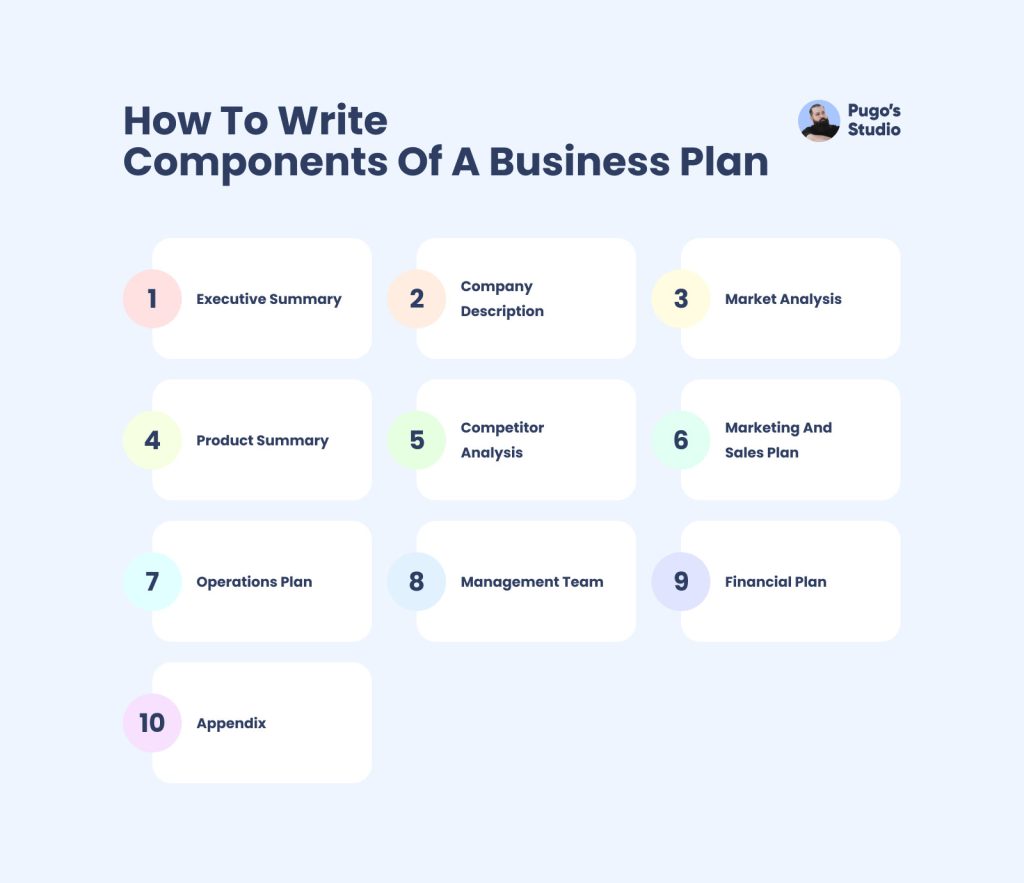
The Components of a Business Plan (Elements of a Business Plan)
Executive Summary
An executive summary is like the trailer for a blockbuster movie – it needs to be compelling enough to make your audience want to see the whole show. This section distills the essence of your entire business plan into a concise, attention-grabbing snapshot. We’ll delve into the art of crafting a standout executive summary and guide you on how to make investors, partners, or stakeholders eager to learn more.
- The Power of First Impressions: Understand the pivotal role an executive summary plays in making the first impression. It’s your business plan’s front door, and it needs to be inviting.
- Clarity and Conciseness: Learn how to distill the essence of your entire business plan into a concise, attention-grabbing snapshot. Cut through the noise and present the core of your business idea.
- Hook Your Audience: Discover strategies for hooking your readers from the very beginning. Your executive summary should be so intriguing that your audience can’t help but read on.
- Highlight Key Points: Identify the most critical aspects of your business plan, such as your unique value proposition and market opportunity, and ensure they shine in your executive summary.
- Inspire Action: Conclude your executive summary with a clear call to action. Whether you’re seeking funding, partnerships, or support, make it easy for your audience to take the next step.
Company Description
Your company’s description is where you lay the foundation for your business. Here, we’ll explore how to paint a vivid picture of your organization, including its mission, vision, and values. You’ll learn how to define what makes your company unique and why it’s well-positioned for success.
- Crafting Your Identity: Understand the significance of a strong company description. It’s your chance to introduce your business’s personality to the world.
- Mission, Vision, and Values: Learn how to define your mission, vision, and values authentically. These pillars provide the ethical and aspirational framework for your company.
- What Sets You Apart: Articulate what makes your company unique and why it stands out in the market. Explain the problem you’re solving and why your solution is the best.
- Building Trust: Showcase your credibility and trustworthiness. Discuss your company’s history, achievements, and any awards or recognition.
- Inspire Confidence: Understand how to inspire confidence in potential partners, investors, and customers by conveying your company’s commitment to excellence and integrity.
Market Analysis
Understanding your market is crucial for any business. In this part, we’ll dig deep into conducting market research, defining your target audience, and analyzing your competition. You’ll gain insights on how to identify market trends and opportunities, setting the stage for strategic decision-making.
- The Market Landscape: Get a comprehensive view of your market. Understand its size, growth potential, and dynamics.
- Know Your Audience: Define your target audience meticulously. Understand their needs, preferences, and pain points.
- Competition Analysis: Analyze your competitors – both direct and indirect. Identify their strengths, weaknesses, and market positioning.
- Trends and Opportunities: Stay ahead of the curve by identifying market trends and emerging opportunities. This knowledge can guide your business strategy.
- Risk Assessment: Be aware of potential risks and challenges in your market. Addressing these proactively can be a significant advantage.
- Data-Driven Decisions: Use data and analytics to inform your market analysis. Concrete information enhances your credibility and decision-making.
Understanding your market inside and out will not only validate your business idea but also provide a solid foundation for your marketing and sales strategies.
Business Structure and Management
Your business’s structure and the team behind it can be pivotal factors in your success. In this section, we’ll explore the various business structures available and help you select the one that best aligns with your goals. Additionally, we’ll guide you on introducing your dream team and showcasing their strengths to instill confidence in potential partners and investors.
- Structural Foundations: Understand the significance of choosing the right business structure. Whether it’s a sole proprietorship, partnership, LLC, or corporation, each has its implications for ownership, liability, and taxation.
- Aligning with Goals: Weigh the pros and cons of different structures against your business objectives. Consider factors like flexibility, taxation, and the level of control you want to maintain.
- Introducing Your Team: Learn how to present your team effectively. Highlight their backgrounds, expertise, and roles within the company to instill trust and inspire confidence.
- Strengths and Synergies: Showcase the strengths and synergies within your team. Emphasize how your team’s collective skills will drive the success of your business.
- Building Trust: Understand how transparency and credibility in presenting your team can be a key factor in securing partnerships and investments.
Products or Services
What you offer and how it stands out are the keys to winning customers. In this section, we’ll guide you in articulating your products or services, emphasizing their unique selling points. Crafting compelling descriptions can turn prospects into loyal customers.
- Defining Your Offering: Clearly define your products or services. Explain how they solve problems or fulfill needs in the market.
- Highlighting Uniqueness: Emphasize what sets your offerings apart from competitors. Identify your unique selling points (USPs) and how they benefit your customers.
- Creating Desirable Descriptions: Learn the art of crafting compelling and customer-centric descriptions. Use language that resonates with your target audience.
- Visual Storytelling: Explore the use of visuals, such as images or videos, to enhance your product/service descriptions. Visuals can provide clarity and engage potential customers.
- Customer-Centric Approach: Focus on the value your offerings bring to customers. Address their pain points and demonstrate how your products or services provide solutions.
Marketing and Sales Strategies
Marketing and sales are the engines that drive your business forward. We’ll show you how to create a comprehensive marketing and sales strategy that will not only attract customers but keep them coming back for more. Learn to master the art of customer acquisition and retention.
- The Marketing-Sales Nexus: Understand the interconnectedness of marketing and sales. They should work in tandem to attract, convert, and retain customers.
- Target Audience: Define your target audience clearly. Tailor your marketing and sales efforts to reach the right people with the right message.
- Customer Acquisition: Explore various customer acquisition channels, from digital marketing to traditional advertising. Understand the customer journey and how to lead prospects through it.
- Retention Strategies: Customer loyalty is invaluable. Develop strategies to keep customers engaged and coming back for repeat business.
- Data-Driven Decisions: Utilize data and analytics to refine your marketing and sales strategies continuously. Measure your efforts and adapt based on performance metrics.
- Customer-Centric Approach: Keep the customer at the center of your strategies. Understand their needs, preferences, and pain points to tailor your marketing and sales efforts effectively.
Funding Requirements
Every business needs a financial foundation to thrive and grow. In this section, we’ll help you estimate your funding needs accurately and explore various sources of capital. Whether you’re considering traditional loans, seeking crowdfunding support, or attracting venture capital, we’ll provide insights on how to present your funding requirements persuasively.
- Assessing Financial Needs: Understand the specific financial requirements of your business. Determine how much capital is necessary to start and sustain your operations, including initial setup, working capital, and growth initiatives.
- Exploring Funding Options: Delve into the diverse landscape of funding sources. We’ll cover traditional avenues such as bank loans and grants, as well as alternative options like angel investors, crowdfunding platforms, and venture capital.
- Pitching Your Plan: Crafting a persuasive funding pitch is essential. We’ll guide you on how to create a compelling case for investors or lenders, demonstrating how your business will generate returns on their investment.
Financial Projections
Numbers tell the story of your business’s future. In this section, we’ll teach you how to create financial forecasts and projections that demonstrate the viability and growth potential of your venture. We’ll break down financial statements, budgets, and cash flow projections into manageable steps.
In this section, we’ll empower you with the skills to create financial forecasts and projections that vividly illustrate the viability and growth potential of your venture. Financial statements, budgets, and cash flow projections might sound daunting, but we’ll break them down into manageable steps.
- Forecasting Revenue: Learn how to project your business’s income realistically. Understand how factors like pricing, sales volume, and market trends influence revenue forecasts.
- Budgeting Essentials: Develop a comprehensive budget that outlines your expected expenses across all facets of your business. Effective budgeting ensures that you allocate resources wisely.
- Cash Flow Management: Explore strategies for managing cash flow effectively. Understand the ebb and flow of money within your business and how to maintain a healthy cash balance.
- Profit and Loss Statements: Dive into the intricacies of profit and loss statements. These documents provide a clear picture of your business’s financial performance over time.
Appendix
The appendix is your toolbox of supplementary materials. We’ll discuss what you should include here, whether it’s additional data, charts, graphs, or any documentation that adds depth to your plan. Understanding how to use the appendix effectively can provide valuable context and support for your business plan.
Think of the appendix as your toolbox of supplementary materials that add depth and credibility to your business plan. In this section, we’ll discuss what you should include here, whether it’s additional data, charts, graphs, or any documentation that enhances your plan.
- Supporting Data: Consider including supporting data that provides context to your business plan. This could be market research, surveys, industry reports, or any data that bolsters your claims.
- Visual Aids: Visual aids such as charts, graphs, and images can clarify complex information. Learn how to incorporate visuals effectively to enhance the reader’s understanding.
- Legal Documents: Depending on your business, you might need to include legal documents like contracts, permits, licenses, or intellectual property information.
- Team Resumes: Showcase your team’s expertise with resumes or biographies. Highlight their relevant experience, qualifications, and contributions to the business.
- Letters of Support: If you have received endorsements, testimonials, or letters of support from industry experts, customers, or partners, this is the place to include them.
Understanding how to use the appendix effectively can provide valuable context and support for your business plan, making it a comprehensive and compelling document.

Creating Your Business Plan
Step-by-Step Guide
Creating a business plan can seem like scaling a mountain, but fear not; we’re here to guide you through every step. In this section, we’ll provide a comprehensive, step-by-step process for crafting your business plan, ensuring that you don’t miss a beat. From the initial research to the final draft, we’ll be your trusted companion on this journey.
Let’s create a business plan for a SaaS product in the social media management and marketing solutions niche. Here’s a step-by-step guide to help you build a comprehensive business plan:
Step 1: Executive Summary
Begin with a concise but compelling executive summary that outlines your business idea, its unique selling points, target market, and financial projections. This section should grab the reader’s attention and provide an overview of what’s to come.
Step 2: Company Description
- Describe your business’s mission, vision, and values.
- Explain the problem your SaaS product solves in the social media management and marketing industry.
- Provide a brief history of your company, including its founding story and any notable achievements.
Step 3: Market Analysis
- Perform market research to identify your target audience, their needs, and pain points.
- Analyze your competitors and highlight what sets your product apart.
- Identify market trends and growth opportunities in the social media management and marketing sector.
Step 4: Business Structure and Management
- Define your company’s legal structure (e.g., LLC, Corporation).
- Introduce key members of your team, their roles, and their qualifications.
- Explain your organizational structure and how responsibilities are divided.
Step 5: Products or Services
- Detail your SaaS product, including its features, functionalities, and benefits.
- Highlight what makes your product unique and how it solves users’ problems.
- Describe any add-on services or features you plan to offer.
Step 6: Marketing and Sales Strategies
- Outline your marketing plan, including strategies for acquiring and retaining customers.
- Define your pricing model, payment plans, and any discounts or promotions.
- Explain your sales strategy, including channels and tactics for reaching customers.
Step 7: Funding Requirements
- Estimate your startup and operational costs.
- Determine how much funding you need to develop, launch, and scale your product.
- Identify potential funding sources, such as investors, loans, or grants.
Step 8: Financial Projections
- Create detailed financial forecasts, including income statements, balance sheets, and cash flow statements.
- Provide financial projections for the next three to five years.
- Highlight key financial metrics like revenue growth, profit margins, and customer acquisition costs.
Step 9: Marketing and Sales Plan
- Explain your marketing strategy, including online and offline tactics.
- Outline your sales strategy, including your sales team structure and sales funnel.
- Set specific marketing and sales goals with measurable key performance indicators (KPIs).
Step 10: Risk Analysis
- Identify potential risks and challenges your business may face.
- Develop contingency plans for mitigating these risks.
- Explain how you will adapt to changing market conditions.
Step 11: Appendix
- Include any additional materials, such as market research data, product prototypes, or resumes of key team members.
- Attach any necessary legal documents or agreements.
Step 12: Review and Finalize
- Review your business plan for clarity, consistency, and completeness.
- Seek feedback from mentors, advisors, or colleagues.
- Make necessary revisions and finalize your business plan.
Remember that your business plan is a dynamic document that should evolve with your business. Regularly revisit and update it as your SaaS product and the market change. A well-crafted business plan not only serves as a roadmap for your company but also as a valuable tool for attracting investors and partners. Good luck with your SaaS venture!
Business Plan Templates and Tools
Why start from scratch when you can leverage the wisdom of experts who’ve walked this path before? To make your business planning journey smoother, we’ll share a collection of downloadable templates and recommend some handy tools. These resources will serve as your building blocks, making it easier to create a plan that’s both comprehensive and compelling. Whether you’re a seasoned entrepreneur or just starting, these templates and tools will be your secret weapons in the battle for business success.
1. Business Model Canvas for Notion & Figma
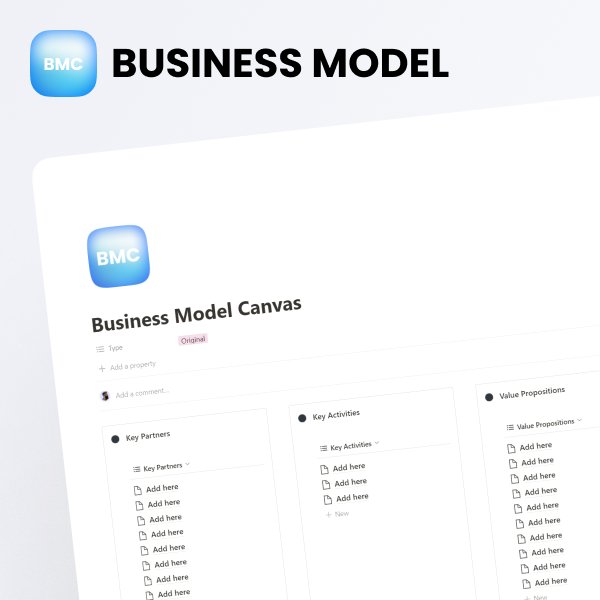
The Business Model Canvas splits a business model into 9 areas and invites you to brainstorm how your business will capitalize on each. Whether you’re starting up a new business or trying to understand an existing one, the Business Model Canvas will help you map it out.
The Business Model Canvas is ideal for quick thinking and brainstorming with sticky notes, so grab your team and start thinking about:
- Value Proposition. What does the business offer to meet the needs of its customers? What distinguishes it from its competitors? Is it something innovative? Price? Quality?
- Key Activities. What does the business do to execute its value proposition?
- Key Resources. What resources does the business have to give it an edge? People? Knowledge? Assets?
- Key Partners. Does the business have any complimentary partnerships or relationships? Joint ventures or strategic alliances?
- Customer Segments. Who are the customers? A niche market or mass appeal? Multiple different segments? Multi-sided market?
- Customer Relationships. What sort of relationship will the business have with its customer segments? High touch sales? Self-service? Community-based?
- Channels. What channels will the business use to get its value proposition to its customers? Marketing? Partnerships? Online or physical?
- Cost Structures. How will the business expenses be structured? Fixed costs and variable costs? Economies of scale? Minimize costs or maximize value?
- Revenue Streams. How will the business make money from its customers? Selling something? Subscription fees? Advertising?
2. SWOT Analysis Template for Notion & Figma
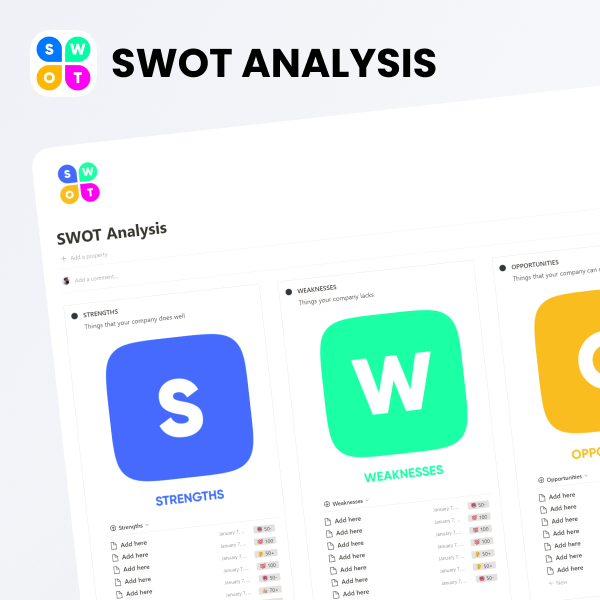
FREE SWOT Analysis Template for Notion & FigJam
A SWOT analysis is designed for strategic thinking: It’s to help you understand where your business is and where you need to go next. Use this template when you’re considering the big picture, like how to best launch a product, what features would best serve your customers, or how you can find new clients.
Running a successful business comes with challenges that make it hard to stand out in any niche. Today, more than ever, your business competitors can easily access the same information and content as you do from the internet.
Therefore, you need a strategy to help you grow your business amidst the stiff competition. The best and most straightforward way to start the growth process is by conducting a SWOT analysis for your company.
This analysis allows you to simplify the project’s intended objectives and highlight the external and internal factors that define how those objectives are achieved. As a result, you can connect the existing actions to plans.
What is a SWOT analysis?
A SWOT analysis is essentially a detailed pros-and-cons list, and it helps you gather your thoughts about the state of your business and organize them.
SWOT stands for strengths, weaknesses, opportunities, and threats. You evaluate your business in these four areas to identify your organization’s strengths and weaknesses and what opportunities and threats surround you. Thanks to the format’s simplicity, anyone can do a SWOT analysis, but you’ll still reap crucial insights to take action on.
3. Product Value Proposition Canvas for Notion & Figma
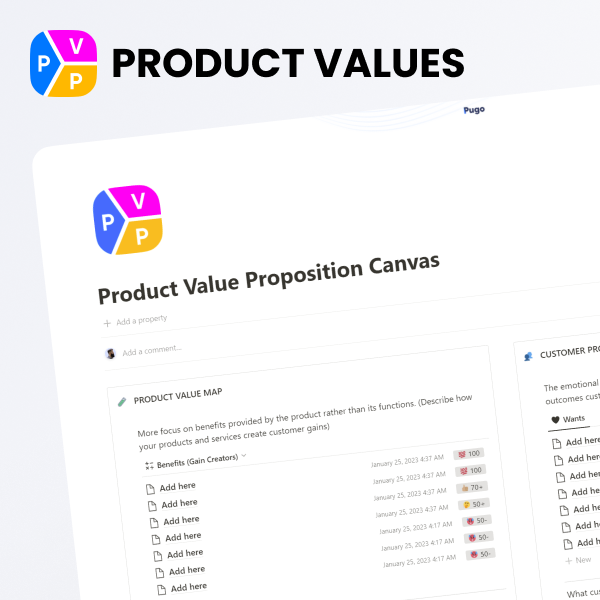
FREE Product Value Proposition Canvas Template for Notion, FigJam, and Print
If you really care about your customers and really want to understand them, then the value proposition canvas is a tool that will transform how you innovate and market your business.
Understanding why customers buy is at the heart of the value proposition canvas.
What Is the Value Proposition Canvas?
The Value Proposition Canvas is a framework that can help ensure that a product or service is positioned around what the customer values and needs. The Value Proposition Canvas was initially developed by Dr. Alexander Osterwalder as a framework to ensure that there is a fit between the product and the market.
The Value Proposition Canvas was developed by Alexander Osterwalder and Yves Pigneur to complement the Business Model Canvas. The canvas focuses on understanding customers problems and producing products or services that solve them.
Telling people you have a great product doesn’t make them want it.
You can produce an awesome product with all the bells and whistles, but if it fundamentally doesn’t help customers, or you don’t explain the value clearly, they won’t buy it.
How-To Prepare your business Value Proposition
- Choose a customer segment/profile.
- Identify the jobs – the things that the customer is trying to get done.
- Create a list of jobs and prioritize them according to how important they are to your customer.
- Identify your customers pains and prioritize them.
- Identify all of their gains and prioritize them.
- Pick the top 3-5 pains and gains that are the most important and relevant – that relate to the most important jobs.
- Create a list of all the benefits your product or service offers to your customers.
- Create a list of pain relievers – things that your product can do to alleviate pain.
- Create a list of gain creators – ways in which your product or service creates customer gains.
- Pick the top ones (gain creators and pain relievers) that make the biggest difference to your customer.
- Link the value your products or services create to your customer and choose the most compelling value generators.
- State clearly how your solution is better than the competition.
- Are there any pains or gains that your product doesn’t address?
- Strategically, are these important for you to compete? If yes then begin to innovate – understand how to create the offer.
- Test your value proposition(s) with your customers.
- Create a value statement that is clear and free of jargon. Avoid gimmicky language. You want your customers to believe and trust you.
4. 289 Impactful Questions to Take Your Business to the Next Level
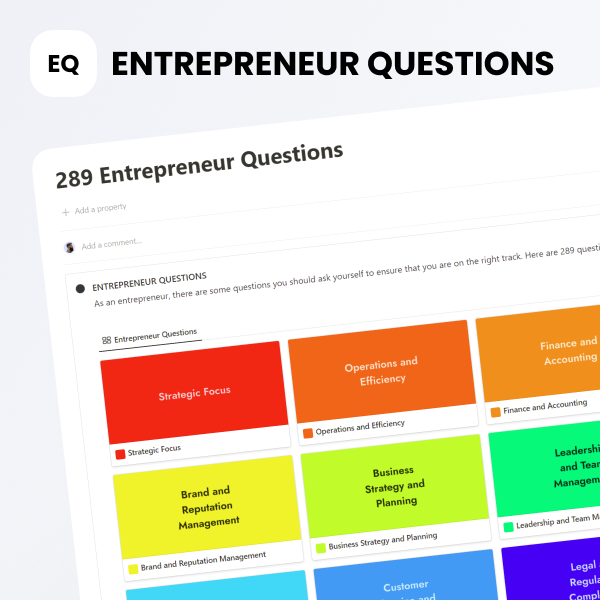
As an entrepreneur, it can be challenging to keep up with the fast-paced and ever-changing business landscape. To stay ahead of the curve, it’s crucial to constantly innovate, adapt, and seek out new opportunities. With this in mind, we’ve compiled a list of 289 impactful questions to help you optimize and improve your business.
Covering everything from customer acquisition to retention, marketing to operations, and finance to technology, our questions will challenge you to critically examine your business and explore new avenues for growth and success.
For example, consider these questions related to operations and efficiency:
- How can you streamline your workflow to save time and resources?
- Are there any bottlenecks in your process that could be eliminated?
- How can you ensure consistent quality in your products or services?
- Can you automate any repetitive tasks to increase efficiency?
Or, if you’re focused on finance and accounting, consider these questions:
- How can you reduce your overhead costs?
- Are there any tax incentives or credits that you’re not taking advantage of?
- How can you better manage your cash flow to ensure financial stability?
- Are there any opportunities for cost-sharing or partnership with other businesses?
Of course, these are just a few examples of the many questions we’ve compiled. Whether you’re a seasoned entrepreneur or just starting out, our list has something for everyone. And by continually challenging yourself and seeking out opportunities, you can stay ahead of the curve and build a thriving business.
Questions Topics
- Strategic Focus
- Operations and Efficiency
- Finance and Accounting
- Marketing and Customer Acquisition
- Brand and Reputation Management
- Business Strategy and Planning
- Leadership and Team Management
- Human Resources and Talent Management
- Sales and Negotiation
- Customer Service and Support
- Legal and Regulatory Compliance
- Technology and Security
- Product and Service Development
We hope this list of questions will inspire you to think creatively about your business and take action toward growth and success. Remember, as an entrepreneur, the journey is never-ending, and there is always room for improvement and innovation. By continually challenging yourself and seeking out opportunities, you can stay ahead of the curve and build a thriving business. Good luck!
So if you’re ready to take your business to the next level, download our list of questions today and discover some of the key strategies and tactics that can help you succeed.
5. Business Hub – Notion Business & Startup Template

Your Business Hub, ENTIRELY in Notion.
Tired of cobbling together multiple apps to form your Business? Me too. Business Hub lets you capture and organize everything inside of Notion – turning it into an all-in-one workspace.
Business Hub is the most advanced business & startup Notion template that helps you manage every aspect of your SaaS product, Digital product, Startup, and in general your online business. (I manage 8 digital businesses with Business Hub, so yes…)
You can manage & track your products, marketing, and growth, teams, projects, tasks, strategies, brand and brandings, OKRs (Objectives and Key Results, KPIs (Key Performance Indicators), budgets, research, user testing, analysis, and finance and everything else you can imagine and you need in your journey to build, run and succeed in your business.
Your Business tools should make your job as a Leader, or as a Player in small or big teams easier, faster, and better.
Business Hub does that.
What’s Inside:
- Brand strategy
- Brand Identity
- Sales Hub (NEW)
- Product management
- User research
- Marketing
- Marketing strategy
- Market research
- Plans & Goals
- Company objectives
- Briefs management
- KPI management
- Sprints & Retrospective
- Financial accounting
- Tips, guides, and articles to help you get started.

Executing Your Business Plan
Turning Vision into Action
Now that you’ve created a meticulously planned business strategy, it’s time to roll up your sleeves and bring that strategy to life. In this section, we’ll delve into the art of turning your well-crafted business plan into tangible actions. It’s one thing to have a brilliant blueprint, but it’s another to bring it to life. We’ll provide you with a toolkit of strategies and insights on how to effectively implement your business plan.
- Set Clear Priorities: Start by identifying the most critical elements of your plan that will drive immediate progress. Establishing priorities ensures that your team focuses on what truly matters.
- Mobilize Your Team: Your team is your greatest asset. Ensure everyone understands their roles and responsibilities in executing the plan. Effective communication and delegation are key.
- Create Milestones: Break down your long-term goals into smaller, achievable milestones. This not only tracks progress but also provides a sense of accomplishment along the way.
- Allocate Resources Wisely: Allocate your budget, time, and manpower judiciously. Be prepared to adapt as you progress and learn where your resources are most effective.
- Regularly Review Progress: Set up regular review meetings to track the execution of your plan. Celebrate achievements and address any issues promptly.
- Embrace Flexibility: While sticking to your plan is important, be open to adjustments when necessary. Market conditions and business landscapes can change rapidly. Adaptation is a sign of a resilient business.
- Maintain Accountability: Hold yourself and your team accountable for meeting targets and deadlines. This fosters a culture of responsibility and achievement.
Monitoring and Adaptation
A successful business plan isn’t set in stone; it’s a dynamic roadmap that evolves with your business and the ever-changing market. In this section, we’ll emphasize the importance of continuous monitoring and adaptation.
- Stay Agile: Agility is the name of the game. Be prepared to pivot when needed. Regularly reassess your strategies and tactics to ensure they align with your goals.
- Spot Potential Pitfalls: Keep a watchful eye for any warning signs or red flags. Identifying issues early allows for proactive solutions, minimizing the impact on your business.
- Gather Feedback: Encourage feedback from your team and customers. Their insights can provide valuable perspectives on how your business is performing and where improvements are needed.
- Data-Driven Decisions: Base your adaptations on data and analytics. Use these insights to refine your strategies and make informed decisions.
- Scenario Planning: Develop contingency plans for various scenarios. This helps you stay prepared for unexpected challenges and reduces the impact of unforeseen events.
- Celebrate Successes: Acknowledge and celebrate your achievements, both big and small. A positive work environment motivates your team and fosters a culture of continuous improvement.
Remember, flexibility and foresight are the cornerstones of executing a winning plan. By embracing change and making informed adaptations, your business plan will remain a relevant and powerful tool guiding your journey to success.

Real-Life Examples and Case Studies for Business Planning
Success Stories
Here, we’ll bring the concepts of business planning and execution to life by sharing inspiring success stories. These real-life case studies will showcase businesses that have not only created exceptional business plans but also executed them flawlessly. You’ll gain valuable insights from these stories, illustrating how planning and execution can lead to remarkable achievements in diverse industries.
1. The Apple Revolution: In the 1970s, two friends, Steve Jobs and Steve Wozniak, started Apple Inc. in a garage. Their business plan aimed to bring personal computing to the masses. With visionary leadership and innovative products like the Macintosh, iPod, iPhone, and iPad, Apple became a tech giant known for design, quality, and user experience. Today, it stands as one of the world’s most influential technology companies, thanks to its meticulous planning and groundbreaking devices.
2. GitHub’s Code to Success: GitHub was founded in 2008, changing how developers collaborate on code. Their business plan centered around creating a platform for open-source projects, fostering collaboration, and simplifying version control. Through strategic planning and a developer-centric approach, GitHub became the go-to platform for code sharing. Microsoft recognized this and acquired GitHub in 2018, showcasing the value of their vision.
3. Microsoft’s Decades of Dominance: Microsoft, founded by Bill Gates and Paul Allen in 1975, created an enduring legacy through strategic planning and adaptability. Their initial business plan focused on personal computing, and they diversified into operating systems, productivity software, and cloud services. Microsoft’s long-term vision and ability to pivot allowed it to maintain its dominance in an ever-changing tech landscape.
4. Tesla: Electrifying the Future: Tesla, led by Elon Musk, emerged in the early 2000s with a plan to accelerate the world’s transition to sustainable energy. Their business plan included electric vehicles and clean energy solutions. Through innovation, they disrupted the automotive industry with electric cars like the Model S and expanded into energy storage and solar products. Tesla’s business strategy has been instrumental in shaping the future of transportation and energy.
5. PayPal: Transforming Finance: Founded in 1998, PayPal’s business plan aimed to simplify online payments. They revolutionized online transactions, making e-commerce safer and more accessible. PayPal’s innovative approach transformed the fintech landscape, and it later became a prominent player in the digital payments industry.
6. Notion’s Note-Worthy Success: Notion Labs Inc. began as a productivity startup, offering a versatile workspace tool. Their business plan focused on user-centered design and scaling. Notion’s commitment to product diversification and user-friendly features has made it a widely used tool in the productivity software industry.
7. OpenAI: Pioneering AI for Good: OpenAI, founded with the mission of advancing AI for the benefit of humanity, has been a driving force in AI research. Their business plan emphasizes responsible AI development and partnerships. OpenAI’s dedication to ethical AI and groundbreaking innovations positions them as pioneers in the field.
8. Amazon: Amazon’s incredible evolution from an online bookstore to a global e-commerce and tech giant is a testament to visionary business planning. Their customer-centric approach, epitomized by their leadership principle of “Customer Obsession,” has been a driving force. Amazon’s diversification into industries like cloud computing (Amazon Web Services), smart devices (Amazon Echo), and even entertainment (Amazon Prime Video) demonstrates their long-term planning prowess. The famous ‘Day One’ philosophy reinforces their commitment to innovation and treating every day like the first day in business.
9. Google: Google’s journey began in a garage as a search engine startup, and it’s now synonymous with internet search and tech innovation. Their unwavering commitment to innovation, as reflected in their ‘Google X’ lab, has led to groundbreaking products like Google Maps, Gmail, and self-driving cars through Waymo. The evolution of their business model from advertising-driven to diversified tech giant (Alphabet Inc.) underscores their adaptability and long-term vision.
10. Starbucks: Starbucks transformed the coffee shop experience, largely through meticulous business planning. Their expansion strategy, which focused on creating a ‘Third Place’ for people to gather, contributed to their global success. Starbucks’ emphasis on quality and sustainability, from ethically sourced coffee beans to their commitment to reducing environmental impact, demonstrates a deep understanding of changing consumer values.
11. SpaceX: SpaceX, under Elon Musk’s leadership, has redefined space exploration. Their ambitious plan to make life multi-planetary is evident in their focus on reusable rockets, significantly reducing the cost of space travel. SpaceX’s adaptability and innovation in developing the Falcon and Starship rocket families, along with their commercial space travel ventures, have reshaped the space industry.
12. Netflix: Netflix’s strategic shift from a DVD rental service to a streaming powerhouse showcases effective business planning. Their investment in original content, exemplified by hit series like ‘Stranger Things’ and ‘House of Cards,’ disrupted the entertainment industry. Netflix’s global expansion and personalized content recommendations have made them a dominant player in the digital entertainment landscape.
13. Airbnb: Airbnb’s innovative business model, which allowed individuals to rent their homes to travelers, disrupted the hospitality industry. Their adaptability and ability to navigate changing regulations worldwide have been critical to their success. Airbnb’s focus on unique and local travel experiences keeps their brand appealing and fresh.
14. Ford: Henry Ford’s introduction of the assembly line revolutionized manufacturing and business planning. It made automobiles affordable for the masses and laid the foundation for the modern automotive industry. Ford’s long-term strategies, including the $5 per day wage for workers, highlighted the importance of investing in both the product and the workforce.
15. Coca-Cola: Coca-Cola’s branding strategies, like the iconic contour bottle and memorable advertisements, have made it one of the world’s most recognized brands. Their global expansion, with localized marketing efforts, showcases adaptability. Coca-Cola’s ability to remain relevant over a century, through changing consumer preferences and health concerns, reflects their commitment to effective business planning.
Highlight Challenges
While success stories inspire, challenges are an integral part of the business journey. In this part, we’ll candidly discuss common hurdles that businesses often encounter during the execution phase. Whether it’s financial setbacks, market shifts, or internal obstacles, we’ll shed light on these challenges and, more importantly, provide actionable strategies to overcome them. Expect a comprehensive guide to navigating the complexities of execution successfully.
Navigating the Terrain – Tips and Best Practices
Congratulations, you’ve embarked on a grand business planning and execution adventure. Now, let’s equip you with some essential tools for your journey.
Practical Tips for Success
- Set SMART Goals: Specific, Measurable, Achievable, Relevant, and Time-bound. These are the guiding stars for your planning phase.
- Market Research Matters: Dive deep into understanding your market, customers, and competition. It’s like having a treasure map to success.
- Incorporate Flexibility: The best plans are like well-folded maps, easy to adjust when the road takes unexpected turns. Stay agile.
- Teamwork Makes the Dream Work: Collaborate, communicate, and empower your team. Everyone should know their role in the expedition.
- Feedback is Fuel: Encourage feedback from all corners – customers, employees, and partners. It’s like a GPS system, keeping you on the right track.
- Risk Mitigation: Identify potential hurdles and create contingency plans. Think of it as packing spare tires for your journey.
Avoiding Common Pitfalls
- Overlooking the Competition: Don’t assume your map is the only one. Keep an eye on what your competitors are plotting.
- Ignoring Market Changes: The market is a dynamic landscape; don’t navigate with outdated maps. Stay updated.
- Underestimating Financial Needs: Running out of fuel mid-journey can be disastrous. Ensure your funding estimates are robust.
- Losing Sight of Your Vision: In the midst of execution, don’t forget the stars you’re chasing. Regularly check your compass.
- Being Inflexible: Rigidity can break the best-laid plans. Be willing to adapt when conditions change.
With these tips and pitfalls in mind, you’re better equipped to sail through your business planning and execution adventure. Stay resilient, stay visionary, and may your journey be filled with success and learning.
Your Toolbox for Business Planning
Welcome to your resource treasure chest! Here, we’ve gathered tools and knowledge to assist you in your business planning voyage.
Recommended Books
- “The Lean Startup” by Eric Ries: Discover a modern approach to business planning that emphasizes agility and experimentation.
- “Good Strategy Bad Strategy” by Richard P. Rumelt: Learn the art of crafting a clear and effective business strategy.
- “Zero to One” by Peter Thiel: Explore unconventional thinking and building a successful startup from scratch.
- “Business Model Generation” by Alexander Osterwalder & Yves Pigneur: Dive into innovative business model development.
- “Scaling Up” by Verne Harnish: When you’re ready to grow, this book offers insights into scaling your business efficiently.
Online Tools and Software
- Trello: A visual project management tool that helps you organize tasks and projects.
- Asana: Streamline your team’s work and communication with this popular project management software.
- LivePlan: An online business planning tool that guides you through the process.
- Gusto: Simplify HR and payroll management for small businesses.
- Google Workspace: Collaborative tools like Google Docs and Sheets are invaluable for planning and documentation.
- Canva: Create professional business plan visuals and presentations.
- Miro: A collaborative online whiteboarding platform to brainstorm and strategize with your team.
Armed with these resources, you’re well-prepared for the exciting and sometimes challenging world of business planning. Remember, every great explorer relies on their tools and knowledge, so keep your compass steady and your toolkit ready. Safe travels!
Navigating Business Planning FAQs
Why is a business plan essential?
A business plan is your roadmap to success. It outlines your goals, strategies, and how you’ll overcome challenges. It’s not just for investors; it keeps you focused and helps secure funding, partnerships, and growth opportunities.
How long should my business plan be?
There’s no one-size-fits-all answer. Business plans vary in length. The key is to be concise yet comprehensive. A typical plan might be 20-30 pages, but it’s more about quality than quantity.
What should I do if my business changes significantly?
Adapt! Business plans are flexible. If your business takes a new direction, revise your plan to reflect this. Change is a sign of growth and innovation.
Do I need a professional to create my business plan?
Not necessarily. While experts can provide valuable insights, many entrepreneurs create effective plans themselves. With research and dedication, you can do it too.
What’s the biggest mistake to avoid in business planning?
Over-optimism. While optimism is great, be realistic in your projections. Overestimating revenue or underestimating costs can lead to issues down the road.
What if my plan doesn’t work as expected?
It happens! Business is unpredictable. Assess what went wrong, adapt, and keep moving forward. Your plan should be a living document, not set in stone.
How often should I update my business plan?
Regularly! Set aside time annually to review and update your plan. This ensures it stays aligned with your goals and evolving market conditions.
Where can I find funding for my business?
Funding sources vary. Explore options like loans, grants, venture capital, angel investors, crowdfunding, or bootstrapping. Each has pros and cons, so choose what suits your business best.
Can I start a business without a plan?
Yes, but it’s like embarking on a journey without a map. A plan gives you direction and a higher chance of success. Even a simple one-page plan is better than none.
How can I make my business plan stand out to investors?
Be clear, concise, and compelling. Focus on your unique value proposition, market research, and financial projections. Show you’ve thought deeply about your venture.
Conclusion: Your Path to Business Success
In this comprehensive guide, we’ve embarked on a journey through the intricate world of business planning. Now, it’s time to recap the key takeaways and set your entrepreneurial spirit in motion.
Key Takeaways:
- Definition and Purpose: We learned that a business plan is your blueprint for success. It’s not just a document; it’s a dynamic tool that guides your business towards its goals. Whether you’re a startup or an established company, a well-crafted plan is invaluable.
- Components of a Business Plan: We delved into the essential elements, from the attention-grabbing executive summary to financial projections. Each section plays a crucial role in shaping your business’s future.
- Execution Matters: Remember that a plan is only as good as its execution. Turning your vision into action and continuously monitoring your progress are vital for success.
- Real-Life Stories: The real-world examples of Apple, GitHub, Microsoft, Tesla, PayPal, Notion, OpenAI, and others demonstrated how effective business planning can lead to remarkable achievements.
- Resources and FAQs: We equipped you with resources for further learning and answered common questions to demystify the planning process.
Now, armed with knowledge and inspiration, it’s your turn to act. Whether you’re launching a startup, scaling your business, or simply ensuring its sustainability, effective planning is your compass.
Remember, the journey may have its challenges, but each obstacle is an opportunity for growth. Stay agile, be persistent, and adapt as needed. Your business plan is your guiding star, but it’s your passion and dedication that will propel you forward.
As you embark on this entrepreneurial voyage, know that you’re not alone. Countless successful businesses began just like yours, armed with a well-thought-out plan and the determination to see it through.
So, take that first step with confidence. Your business’s success story is waiting to be written. Now, go and make it extraordinary!
Find the business plan templates you need to start your planning:

















